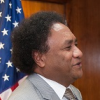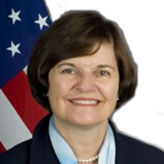Papua New Guinea
Lay of the Land: Papua New Guinea is located north of Australia and east of Indonesia. It consists of the eastern half of the island of New Guinea, second largest in the world, plus the large offshore islands of New Britain, New Ireland, and many smaller ones. The terrain is varied and includes coastal swamps, large river valleys, highland plateaus and rugged mountain ranges.
The United States maintains an embassy in Port Moresby. Relations between the United States and Papua New Guinea are good. There is a fishing treaty that has been in effect for several years providing money to the PNG government. The United States also has many aid programs, including helping rebuild Bougainville and fight HIV/AIDS.
In 2007 the United States imported $108,516,000 worth of goods from Papua New Guinea. Green coffee, cocoa beans and fish accounted for 90% of U.S. imports from Papua. That same year the United States exported to Papua New Guinea goods worth $65,889,000. The primary categories included aircraft parts, drilling equipment and industrial engines. U.S. aid to Papua New Guinea for 2008 included $280,000 for military training to enhance border control and maritime security and $2,080,000 to help fight a growing HIV/AIDS epidemic.
Human rights problems in the country, which include arbitrary or unlawful killings by police; police abuse of detainees, including children; poor prison conditions; lengthy pretrial detention; infringement of citizens' privacy rights; government corruption; violence and discrimination against women and children; discrimination against persons with disabilities; and intertribal violence.
Robert W. Fitts 9/11/03-10/2/06 (also accredited to Solomon Islands and Vanuatu)
 Mulina, Rupa
Mulina, Rupa
Rupa Mulina took over as the ambassador from Papua New Guinea to the United States in March 2014, about a year and a half after his appointment was announced. Mulina is also accredited to Canada and Mexico.
Mulina is from Papua New Guinea’s Central Province. He came to the United States as a graduate student on a Hubert H. Humphrey Fellowship in 1987, studying at Boston University until 1988.
Mulina worked his way quickly through the ranks of the Papua New Guinea government. He served as deputy secretary in the Department of Finance and Planning and by 1994 was secretary of defense. In 1996 Mulina was secretary of finance and under his watch, the World Bank warned the government of Papua New Guinea of restrictions on future aid because it had not adhered to conditions of previous programs. Mulina was named to head the government-owned Papua New Guinea Banking Corporation in 1997. In 2003 he became the chairman of the Rural Development Bank.
Mulina also worked in the private sector and before his appointment as ambassador was manager of Ambate RG Pacific, a company promoting a geothermal project in Rabaul. He had previously worked as executive assistant to the chairman in Papua New Guinea’s Office of Climate Change.
-Steve Straehley
- Table of Contents
- News
- Overview
- Basic Information
- History
- Newspapers
- History of U.S. Relations with Papua New Guinea
- Current U.S. Relations with Papua New Guinea
- Where Does the Money Flow
- Controversies
- Human Rights
- Debate
- Past Ambassadors
- Ambassador to the U.S.
- Embassy Web Site in the U.S.
- Comments
- Leave a comment
U.S. Ambassador to Papua New Guinea

The next ambassador to the South Pacific nations of Papua New Guinea, Solomon Islands and Vanuatu will be Walter E. North, a career member of the Senior Foreign Service, class of Career-Minister, who has spent his career at the U.S. Agency for International Development (USAID). Nominated by President Obama on July 10, 2012, North’s appointment is subject to confirmation by the Senate. The Senate Foreign Relations Committee held a hearing on North’s nomination on September 12.
Born circa 1950 and raised in Mount Hermon, Massachusetts, North earned a BA in Theatre-Drama at Lawrence University in Appleton, Wisconsin, in 1972, a JD at the George Washington University Law School, and an MPA at Harvard University’s Kennedy School of Government in 1990.
North served as a Peace Corps volunteer in Ethiopia from 1973 to 1975, working in Bonga and Addis Ababa, and was a project manager for the non-profit, humanitarian organization, CARE International, in India and Bangladesh. He joined USAID in 1980, and served at USAID Headquarters in Washington with the Offices of East Asian Affairs and East African Affairs from 1985 to 1992.
North served a string of overseas assignments for the next 12 years, as deputy USAID mission director in Addis Ababa, Ethiopia, from 1992 to 1996; as USAID mission director in Lusaka, Zambia, from 1996 to 2000; and as USAID mission director in New Delhi, India, from 2000 to 2004, where he also served as acting deputy chief of mission at the U.S. embassy from 2003 to 2004.
Returning stateside to USAID’s Washington headquarters, North served as deputy assistant administrator for the Bureau for Asia and the Near East from 2004 to 2005, as deputy assistant administrator for the Bureau for Policy and Program Coordination from 2005 to 2006, and as interim assistant administrator for the Bureau for Africa from 2006 to 2007.
Most recently, North served as USAID mission director in Jakarta, Indonesia, from 2007 to 2011, and as USAID mission director in Cairo, Egypt, from 2011 to 2012.
North and his wife, Dr. Judy Ryon, have two children.
-Matt Bewig
President Obama Nominates Lawrence University Alumnus for U.S. Ambassadorship (Lawrence University News)
morePrevious U.S. Ambassador to Papua New Guinea

Lay of the Land: Papua New Guinea is located north of Australia and east of Indonesia. It consists of the eastern half of the island of New Guinea, second largest in the world, plus the large offshore islands of New Britain, New Ireland, and many smaller ones. The terrain is varied and includes coastal swamps, large river valleys, highland plateaus and rugged mountain ranges.
The United States maintains an embassy in Port Moresby. Relations between the United States and Papua New Guinea are good. There is a fishing treaty that has been in effect for several years providing money to the PNG government. The United States also has many aid programs, including helping rebuild Bougainville and fight HIV/AIDS.
In 2007 the United States imported $108,516,000 worth of goods from Papua New Guinea. Green coffee, cocoa beans and fish accounted for 90% of U.S. imports from Papua. That same year the United States exported to Papua New Guinea goods worth $65,889,000. The primary categories included aircraft parts, drilling equipment and industrial engines. U.S. aid to Papua New Guinea for 2008 included $280,000 for military training to enhance border control and maritime security and $2,080,000 to help fight a growing HIV/AIDS epidemic.
Human rights problems in the country, which include arbitrary or unlawful killings by police; police abuse of detainees, including children; poor prison conditions; lengthy pretrial detention; infringement of citizens' privacy rights; government corruption; violence and discrimination against women and children; discrimination against persons with disabilities; and intertribal violence.
Robert W. Fitts 9/11/03-10/2/06 (also accredited to Solomon Islands and Vanuatu)
 Mulina, Rupa
Mulina, Rupa
Rupa Mulina took over as the ambassador from Papua New Guinea to the United States in March 2014, about a year and a half after his appointment was announced. Mulina is also accredited to Canada and Mexico.
Mulina is from Papua New Guinea’s Central Province. He came to the United States as a graduate student on a Hubert H. Humphrey Fellowship in 1987, studying at Boston University until 1988.
Mulina worked his way quickly through the ranks of the Papua New Guinea government. He served as deputy secretary in the Department of Finance and Planning and by 1994 was secretary of defense. In 1996 Mulina was secretary of finance and under his watch, the World Bank warned the government of Papua New Guinea of restrictions on future aid because it had not adhered to conditions of previous programs. Mulina was named to head the government-owned Papua New Guinea Banking Corporation in 1997. In 2003 he became the chairman of the Rural Development Bank.
Mulina also worked in the private sector and before his appointment as ambassador was manager of Ambate RG Pacific, a company promoting a geothermal project in Rabaul. He had previously worked as executive assistant to the chairman in Papua New Guinea’s Office of Climate Change.
-Steve Straehley
Comments
U.S. Ambassador to Papua New Guinea

The next ambassador to the South Pacific nations of Papua New Guinea, Solomon Islands and Vanuatu will be Walter E. North, a career member of the Senior Foreign Service, class of Career-Minister, who has spent his career at the U.S. Agency for International Development (USAID). Nominated by President Obama on July 10, 2012, North’s appointment is subject to confirmation by the Senate. The Senate Foreign Relations Committee held a hearing on North’s nomination on September 12.
Born circa 1950 and raised in Mount Hermon, Massachusetts, North earned a BA in Theatre-Drama at Lawrence University in Appleton, Wisconsin, in 1972, a JD at the George Washington University Law School, and an MPA at Harvard University’s Kennedy School of Government in 1990.
North served as a Peace Corps volunteer in Ethiopia from 1973 to 1975, working in Bonga and Addis Ababa, and was a project manager for the non-profit, humanitarian organization, CARE International, in India and Bangladesh. He joined USAID in 1980, and served at USAID Headquarters in Washington with the Offices of East Asian Affairs and East African Affairs from 1985 to 1992.
North served a string of overseas assignments for the next 12 years, as deputy USAID mission director in Addis Ababa, Ethiopia, from 1992 to 1996; as USAID mission director in Lusaka, Zambia, from 1996 to 2000; and as USAID mission director in New Delhi, India, from 2000 to 2004, where he also served as acting deputy chief of mission at the U.S. embassy from 2003 to 2004.
Returning stateside to USAID’s Washington headquarters, North served as deputy assistant administrator for the Bureau for Asia and the Near East from 2004 to 2005, as deputy assistant administrator for the Bureau for Policy and Program Coordination from 2005 to 2006, and as interim assistant administrator for the Bureau for Africa from 2006 to 2007.
Most recently, North served as USAID mission director in Jakarta, Indonesia, from 2007 to 2011, and as USAID mission director in Cairo, Egypt, from 2011 to 2012.
North and his wife, Dr. Judy Ryon, have two children.
-Matt Bewig
President Obama Nominates Lawrence University Alumnus for U.S. Ambassadorship (Lawrence University News)
morePrevious U.S. Ambassador to Papua New Guinea








Comments